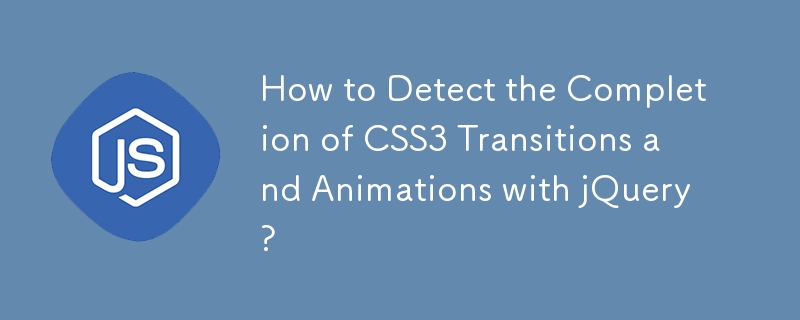 Web Front-end
Web Front-end
 JS Tutorial
JS Tutorial
 How to Detect the Completion of CSS3 Transitions and Animations with jQuery?
How to Detect the Completion of CSS3 Transitions and Animations with jQuery?
How to Detect the Completion of CSS3 Transitions and Animations with jQuery?
Nov 04, 2024 am 07:35 AM
Detecting the Completion of CSS3 Transitions and Animations Using jQuery
Transitioning elements with CSS3 offers smoother animations than traditional JavaScript techniques. However, when working with CSS3 animations, the question arises: how can you determine when the transition has completed?
jQuery provides a solution for this need. To monitor the end of a CSS3 transition, you can bind an event handler using the following syntax:
<code class="javascript">$("#someSelector").bind("transitionend webkitTransitionEnd oTransitionEnd MSTransitionEnd", function(){ ... });</code>
Similarly, for CSS3 animations, you can use:
<code class="javascript">$("#someSelector").bind("animationend webkitAnimationEnd oAnimationEnd MSAnimationEnd", function(){ ... });</code>
By providing all the browser-prefixed event strings in the bind() method, you ensure compatibility across browsers.
Ensuring Single Execution of the Handler
To prevent repeated execution of the handler, you can employ jQuery's .one() method. For instance:
<code class="javascript">$("#someSelector").one("transitionend webkitTransitionEnd oTransitionEnd MSTransitionEnd", function(){ ... });
$("#someSelector").one("animationend webkitAnimationEnd oAnimationEnd MSAnimationEnd", function(){ ... });</code>
Depreciation of .bind() Method
jQuery's bind() method has been deprecated in favor of .on(). Therefore, you should use:
<code class="javascript">$("#someSelector")
.on("animationend webkitAnimationEnd oAnimationEnd MSAnimationEnd",
function(e){
// do something here
$(this).off(e);
});</code>
This method also ensures that the handler is executed only once.
For further details, refer to the following references:
- [jQuery .off()](https://api.jquery.com/off/)
- [jQuery .one()](https://api.jquery.com/one/)
The above is the detailed content of How to Detect the Completion of CSS3 Transitions and Animations with jQuery?. For more information, please follow other related articles on the PHP Chinese website!

Hot AI Tools

Undress AI Tool
Undress images for free

Undresser.AI Undress
AI-powered app for creating realistic nude photos

AI Clothes Remover
Online AI tool for removing clothes from photos.

Clothoff.io
AI clothes remover

Video Face Swap
Swap faces in any video effortlessly with our completely free AI face swap tool!

Hot Article

Hot Tools

Notepad++7.3.1
Easy-to-use and free code editor

SublimeText3 Chinese version
Chinese version, very easy to use

Zend Studio 13.0.1
Powerful PHP integrated development environment

Dreamweaver CS6
Visual web development tools

SublimeText3 Mac version
God-level code editing software (SublimeText3)

Hot Topics
 JavaScript vs. Java: Which Language Should You Learn?
Jun 10, 2025 am 12:05 AM
JavaScript vs. Java: Which Language Should You Learn?
Jun 10, 2025 am 12:05 AM
JavaScriptisidealforwebdevelopment,whileJavasuitslarge-scaleapplicationsandAndroiddevelopment.1)JavaScriptexcelsincreatinginteractivewebexperiencesandfull-stackdevelopmentwithNode.js.2)Javaisrobustforenterprisesoftwareandbackendsystems,offeringstrong
 Which Comment Symbols to Use in JavaScript: A Clear Explanation
Jun 12, 2025 am 10:27 AM
Which Comment Symbols to Use in JavaScript: A Clear Explanation
Jun 12, 2025 am 10:27 AM
In JavaScript, choosing a single-line comment (//) or a multi-line comment (//) depends on the purpose and project requirements of the comment: 1. Use single-line comments for quick and inline interpretation; 2. Use multi-line comments for detailed documentation; 3. Maintain the consistency of the comment style; 4. Avoid over-annotation; 5. Ensure that the comments are updated synchronously with the code. Choosing the right annotation style can help improve the readability and maintainability of your code.
 The Ultimate Guide to JavaScript Comments: Enhance Code Clarity
Jun 11, 2025 am 12:04 AM
The Ultimate Guide to JavaScript Comments: Enhance Code Clarity
Jun 11, 2025 am 12:04 AM
Yes,JavaScriptcommentsarenecessaryandshouldbeusedeffectively.1)Theyguidedevelopersthroughcodelogicandintent,2)arevitalincomplexprojects,and3)shouldenhanceclaritywithoutclutteringthecode.
 Java vs. JavaScript: Clearing Up the Confusion
Jun 20, 2025 am 12:27 AM
Java vs. JavaScript: Clearing Up the Confusion
Jun 20, 2025 am 12:27 AM
Java and JavaScript are different programming languages, each suitable for different application scenarios. Java is used for large enterprise and mobile application development, while JavaScript is mainly used for web page development.
 Javascript Comments: short explanation
Jun 19, 2025 am 12:40 AM
Javascript Comments: short explanation
Jun 19, 2025 am 12:40 AM
JavaScriptcommentsareessentialformaintaining,reading,andguidingcodeexecution.1)Single-linecommentsareusedforquickexplanations.2)Multi-linecommentsexplaincomplexlogicorprovidedetaileddocumentation.3)Inlinecommentsclarifyspecificpartsofcode.Bestpractic
 Mastering JavaScript Comments: A Comprehensive Guide
Jun 14, 2025 am 12:11 AM
Mastering JavaScript Comments: A Comprehensive Guide
Jun 14, 2025 am 12:11 AM
CommentsarecrucialinJavaScriptformaintainingclarityandfosteringcollaboration.1)Theyhelpindebugging,onboarding,andunderstandingcodeevolution.2)Usesingle-linecommentsforquickexplanationsandmulti-linecommentsfordetaileddescriptions.3)Bestpracticesinclud
 JavaScript Data Types: A Deep Dive
Jun 13, 2025 am 12:10 AM
JavaScript Data Types: A Deep Dive
Jun 13, 2025 am 12:10 AM
JavaScripthasseveralprimitivedatatypes:Number,String,Boolean,Undefined,Null,Symbol,andBigInt,andnon-primitivetypeslikeObjectandArray.Understandingtheseiscrucialforwritingefficient,bug-freecode:1)Numberusesa64-bitformat,leadingtofloating-pointissuesli
 JavaScript vs. Java: A Comprehensive Comparison for Developers
Jun 20, 2025 am 12:21 AM
JavaScript vs. Java: A Comprehensive Comparison for Developers
Jun 20, 2025 am 12:21 AM
JavaScriptispreferredforwebdevelopment,whileJavaisbetterforlarge-scalebackendsystemsandAndroidapps.1)JavaScriptexcelsincreatinginteractivewebexperienceswithitsdynamicnatureandDOMmanipulation.2)Javaoffersstrongtypingandobject-orientedfeatures,idealfor





